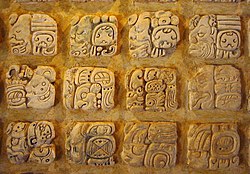
The Mayan languages form a language family spoken in Mesoamerica, both in the south of Mexico and northern Central America. Mayan languages are spoken by at least six million Maya people, primarily in Guatemala, Mexico, Belize, El Salvador and Honduras. In 1996, Guatemala formally recognized 21 Mayan languages by name, and Mexico recognizes eight within its territory.

The Indigenous languages of the Americas are the languages that were used by the Indigenous peoples of the Americas before the arrival of non-Indigenous peoples. Over a thousand of these languages are still used today, while many more are now extinct. The Indigenous languages of the Americas are not all related to each other; instead, they are classified into a hundred or so language families, as well as a number of extinct languages that are unclassified due to the lack of information on them.

Lacandon is a Mayan language spoken by all of the 1,000 Lacandon people in the state of Chiapas in Mexico. Within Chiapas, Lacandon is spoken in Betel, Lacanjá San Quintín, Lake Metzaboc, Metzaboc, and Najá.

Mesoamerican languages are the languages indigenous to the Mesoamerican cultural area, which covers southern Mexico, all of Guatemala, Belize, El Salvador, and parts of Honduras, Nicaragua and Costa Rica. The area is characterized by extensive linguistic diversity containing several hundred different languages and seven major language families. Mesoamerica is also an area of high linguistic diffusion in that long-term interaction among speakers of different languages through several millennia has resulted in the convergence of certain linguistic traits across disparate language families. The Mesoamerican sprachbund is commonly referred to as the Mesoamerican Linguistic Area.
The Ch'ol (Chol) language is a member of the western branch of the Mayan language family used by the Ch'ol people in the states of Chiapas, Tabasco, and Campeche in Mexico. This language, together with Chontal, Ch'orti', and Ch'olti', constitute the Cholan language group.

Amuzgo is an Oto-Manguean language spoken in the Costa Chica region of the Mexican states of Guerrero and Oaxaca by about 44,000 speakers. Like other Oto-Manguean languages, Amuzgo is a tonal language. From syntactical point of view Amuzgo can be considered as an active language. The name Amuzgo is claimed to be a Nahuatl exonym but its meaning is shrouded in controversy; multiple proposals have been made, including 'moss-in'.

Indigenous peoples of Mexico, Native Mexicans or Mexican Native Americans, are those who are part of communities that trace their roots back to populations and communities that existed in what is now Mexico before the arrival of Europeans.
Yokotʼan (self-denomination), also known as Chontal Maya, is a Maya language of the Cholan family spoken in 2020 by around 60,000 Chontal Maya people of the Mexican state of Tabasco. According to the National Catalog of Indigenous Languages of Mexico-INALI, Yokotʼan has at least four dialects: Nacajuca (Central), Centla (Northern), Macuspana (Southern) and Tamulte (Eastern).

Otomi is an Oto-Pamean language spoken by approximately 240,000 indigenous Otomi people in the central altiplano region of Mexico. Otomi consists of several closely related languages, many of which are not mutually intelligible. The word Hñähñu has been proposed as an endonym, but since it represents the usage of a single dialect, it has not gained wide currency. Linguists have classified the modern dialects into three dialect areas: the Northwestern dialects are spoken in Querétaro, Hidalgo and Guanajuato; the Southwestern dialects are spoken in the State of Mexico; and the Eastern dialects are spoken in the highlands of Veracruz, Puebla, and eastern Hidalgo and villages in Tlaxcala and Mexico states.
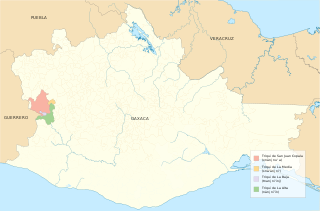
The Triqui, or Trique, languages are a family of Oto-Manguean spoken by 30,000 Trique people of the Mexican states of Oaxaca and the state of Baja California in 2007. They are also spoken by 5,000 immigrants to the United States. Triqui languages belong to the Mixtecan branch together with the Mixtec languages and Cuicatec.
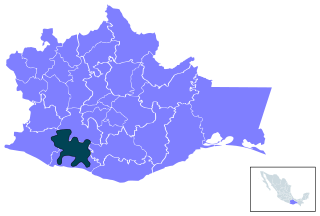
Chatino is a group of indigenous Mesoamerican languages. These languages are a branch of the Zapotecan family within the Oto-Manguean language family. They are natively spoken by 45,000 Chatino people, whose communities are located in the southern portion of the Mexican state of Oaxaca.
Sayula Popoluca, also called Sayultec, is a Mixe language spoken by around 5,000 indigenous people in and around the town of Sayula de Alemán in the southern part of the state of Veracruz, Mexico. Almost all published research on the language has been the work of Lawrence E. Clark of the Summer Institute of Linguistics. More recent studies of Sayula Popoluca have been conducted by Dennis Holt (lexico-semantics) and Richard A. Rhodes, but few of their findings have been published.
Pochutec is an extinct Uto-Aztecan language of the Nahuan branch which was spoken in and around the town of Pochutla on the Pacific coast of Oaxaca, Mexico. In 1917 it was documented in a monograph by Franz Boas, who considered the language nearly extinct. In the 1970s another investigator found two speakers around Pochutla who still remembered a few of the words recorded by Boas.
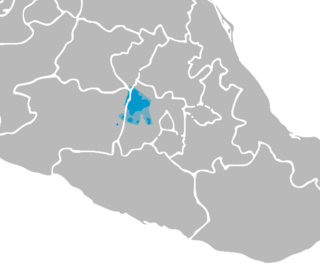
The Mazahua language is an Oto-Pamean language spoken in the central states of Mexico by the ethnic group that is widely known as the Mazahua but calls itself the Hñatho. It is a Mesoamerican language and has many of the traits of the Mesoamerican Linguistic Area. In 2003, along with some 62 other indigenous languages, it was recognised by a statutory law of Mexico as an official language in the Federal District and the other administrative divisions in which it is spoken, and on an equal footing with Spanish. The largest concentration of Mazahua is found in the municipality of San Felipe del Progreso, State of México, near Toluca.
The Instituto Nacional de Lenguas Indígenas better known by its acronym INALI, is a Mexican federal public agency, created 13 March 2003 by the enactment of the Ley General de Derechos Lingüísticos de los Pueblos Indígenas by the administration of President Vicente Fox Quesada.
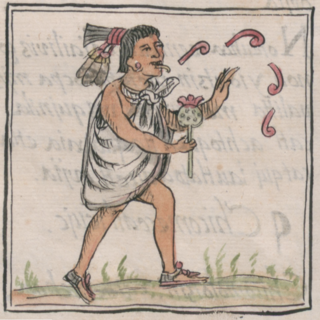
Nahuatl, Aztec, or Mexicano is a language or, by some definitions, a group of languages of the Uto-Aztecan language family. Varieties of Nahuatl are spoken by about 1.7 million Nahua peoples, most of whom live mainly in Central Mexico and have smaller populations in the United States.

The Indigenous people of Oaxaca are descendants of the inhabitants of what is now the state of Oaxaca, Mexico, who were present before the Spanish invasion. Several cultures flourished in the ancient region of Oaxaca from as far back as 2000 BC, of whom the Zapotecs and Mixtecs were perhaps the most advanced, with complex social organization and sophisticated arts.
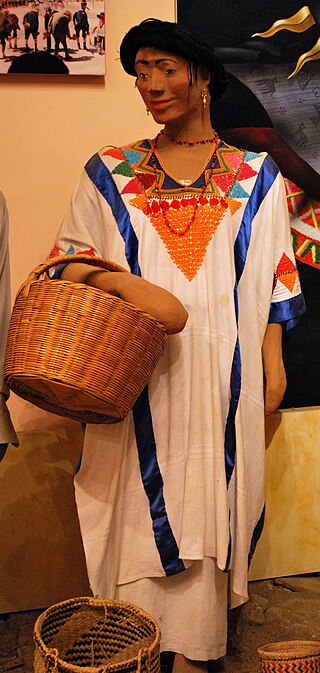
The state of Oaxaca, Mexico has a total population of about 3.5 million, with women outnumbering men by 150,000 and about 60% of the population under the age of 30. It is ranked tenth in population in the country. Fifty three percent of the population lives in rural areas. Most of the state’s population growth took place between 1980 and 1990. Life expectancy is 71.7 for men and 77.4 for women, just under the national average. Births far outpace deaths. In 2007, there were 122,579 births and 19,439 deaths. Approximately 85% profess the Catholic faith.

The Nahuatl language in the United States is spoken primarily by Mexican immigrants from indigenous communities and Chicanos who study and speak Nahuatl as L2. Despite the fact that there is no official census of the language in the North American country, it is estimated that there are around 140,800 Nahuatl speakers. During the last decades, the United States has carried out many educational initiatives aimed at teaching Nahuatl as a language of cultural heritage.

The history of the Nahuatl, Aztec or Mexicano language can be traced back to the time when Teotihuacan flourished. From the 4th century AD to the present, the journey and development of the language and its dialect varieties have gone through a large number of periods and processes, the language being used by various peoples, civilizations and states throughout the history of the cultural area of Mesoamerica.




